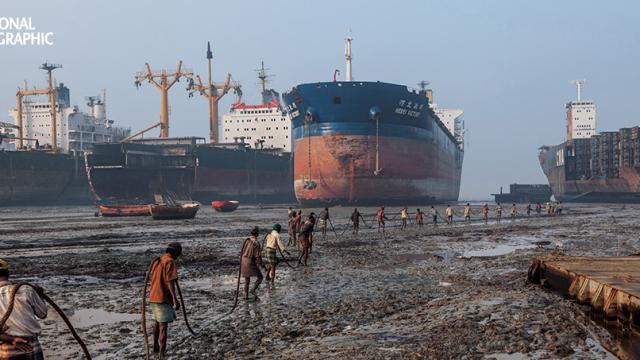On the Bangladeshi coast of the Bay of Bengal, past-their-prime oil tankers and cargo vessels are beached on the muddy shore like industrial, open-air graveyards. There, these massive ships are taken apart by men — “ship-breakers” — who toil hand-to-metal for minimal wages on the toxic, exceptionally dangerous sites.
A Maritime Graveyard: A satellite image shows a 1.6km long stretch of the bangladeshi coast just north of chittagong, where ships from around the world are beached and dismantled. Thirteen kilometres of mangroves have been cleared for the shipbreaking yards, which are often little more than a sliver of beach wide enough for a single large ship. The coast now holds 80 active yards, with new ones added each year.
National Geographic‘s Peter Gwin offers a fascinating glimpse at the treacherous practice, where nearly everything on these decades-old liners — from the remaining fuel, machinery and fittings to the engines, and lifeboats — is scavenged and resold or recycled for a profit that can reach upwards of a million dollars per ship over the demolition span of three to four months.
After workers spent several days cutting through the decks of the Leona I, a large section suddenly crashes, sending shards of steel flying toward the yard managers. Built in Split, Croatia, the cargo vessel was at sea for 30 years, about the average ship’s life span.
At low tide ship-breakers haul a 4500kg cable to a beached ship to winch pieces ashore as they dismantle it.
The work itself is harrowing, and those who survive are often left with deep scars, both physical and psychological. Photographer Mike Hettwer’s images show the incredible disparity in scale between man and machine — it’s hard to imagine that people can have any effect on these sea beasts at all. Head over to NatGeo for the full story and more pics. [National Geographic]
Pictures: Mike Hettwer/National Geographic, from the May issue of National Geographic magazine.
